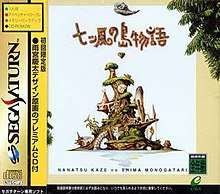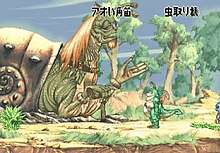Nanatsu Kaze no Shima Monogatari
Nanatsu Kaze no Shima Monogatari[lower-alpha 1] is a 1997 graphic adventure video game developed by Givro Corporation and published by Enix for the Sega Saturn. The last game to be created by Givro prior to their dissolution in 1998,[1][2] the title takes place on a mysterious island, as players assume the role of a dragon named Gaūpu to meet various creatures inhabiting the location while harnessing seven legendary winds to overcome obstacles. It received positive reception from critics and reviewers alike, with high praise given towards its hand-drawn visuals.
| Nanatsu Kaze no Shima Monogatari | |
|---|---|
 | |
| Developer(s) | Givro Corporation |
| Publisher(s) | Enix |
| Designer(s) | Norihiro Sawada |
| Programmer(s) | Noriyuki Tomiyama |
| Artist(s) | Keita Amemiya Naoyuki Hayakawa Yasuo Wakatsuki |
| Composer(s) | Hirokazu Ohta (Buddy Zoo) Shinji Kinoshita (Buddy Zoo) |
| Platform(s) | Sega Saturn |
| Release |
|
| Genre(s) | Graphic adventure |
| Mode(s) | Single-player |
Gameplay

Nanatsu Kaze no Shima Monogatari is a graphic adventure game reminiscent of earlier titles from Givro like Wonder Project J and Wonder Project J2 on Super Famicom and Nintendo 64 respectively, where players assume the role of a dragon named Gaūpu who falls into a mysterious island and must meet various creatures that inhabits the location, some of which will join Gaūpu's quest or give information, collect items while harnessing seven legendary winds to overcome challenges along the way.[3][4][5][6] Gameplay is largely free of violence and focuses on puzzle solving instead.[7] Players collect a variety of items such as insects, plants and fish, which can be used for certain purposes.[3][4][5][6] Characters like the giant snail Soul and the trader Tamu provides hints in the form of ambiguous poems and gives items to Gaūpu respectively.[3][4][6] By using a sea conch item, Gaūpu can summon companions to clear obstacles in order explore previously unreachable areas of the island.[3][4][5][6]
Production
Development
Developed by Givro Corporation, it was the last game the company developed.[1][8][9][10]
Creature design
Release
Nanatsu Kaze no Shima Monogatari was published by Enix for the Sega Saturn on November 27, 1997.[11][12] It was never released outside of Japan.[13] The title was released with two discs; one featuring the main game while another features artwork and character designs.[6][14] On December 1997, an official strategy guide was released in Japan by Enix.[3] Likewise, an album containing music from the title was co-published in Japan by First Smile Entertainment and Pony Canyon on December 17 of the same year.[15]
Reception
| Reception | ||||||||||
|---|---|---|---|---|---|---|---|---|---|---|
| ||||||||||
Famitsu gave it a score of 29 out of 40.[16] Three reviewers for the Japanese Sega Saturn Magazine gave it a 9, 4, and a 6 score, for an average of 7.[18] Grégoire Hellot of French magazine Joypad gave it a 98%.[17] 1UP.com's Todd Ciolek called it one of the most gorgeous 2D games ever created.[1] Anthony John Agnello at Engadget compared as a mix of puzzle solving titles like King's Quest and platforming games like Castlevania.[7]
Notes
- Japanese: 七ツ風の島物語, lit. "The Seven Blasts of Wind in Island Story" or "The Tale of Seven Winds Island"
References
- Ciolek, Todd (August 6, 2012). "Falls from Grace: How Four Creative Game Companies Went Astray - Givro: Growing Pains". 1UP.com. IGN. Archived from the original on 2012-11-02. Retrieved 2020-08-08.
- Yoneda, Takashi (2003). "Hirano Bucho-Do: Cyber Games Profile". Takashi Yoneda Official Website. Archived from the original on 2003-03-26. Retrieved 2020-08-12.
- 七ツ風の島物語 公式ガイドブック ― Picture Imagination Book (in Japanese). Enix. December 1997. pp. 1–104. ISBN 978-4870256897.
- Nanatsu Kaze no Shima Monogatari manual (Sega Saturn, JP)
- "Sega Saturn Soft Complete Guide - 七ツ風の島物語". Sega Saturn Magazine (in Japanese). No. 79. SoftBank Creative. 12 December 1997. pp. 180–185.
- de Figueiredo, Bruno (29 June 2017). "Nanatsu Kaze no Shima Monogatari". Hardcore Gaming 101. Archived from the original on 2018-01-30. Retrieved 2020-08-11.
- Agnello, Anthony John (11 May 2015). "Seven Sega Saturn oddities you never played". Engadget. Verizon Media. Archived from the original on 2016-05-24. Retrieved 2020-08-11.
- "七ツ風の島物語 - Givro (ギブロ)". Sega Saturn Magazine (in Japanese). No. 54. SoftBank Creative. 6 June 1997. p. 33.
- "BUDDY ZOO (バディーズー) - プロフィール (Profile)" (in Japanese). Buddy Zoo. 2013. Archived from the original on 2019-06-17. Retrieved 2020-08-11.
- Amemiya, Keita (2007). "SPECIAL - 七ッ風の島物語 デザイン画" (in Japanese). Crowd. Archived from the original on 2020-08-12. Retrieved 2020-08-12.
- "セガサターン対応ソフトウェア(ライセンシー発売)- 1997年発売". SEGA HARD Encyclopedia (in Japanese). Sega. 2020. Archived from the original on 2020-03-20. Retrieved 2020-08-11.
- "七ツ風の島物語" (in Japanese). Square Enix. 2020. Archived from the original on 2017-07-22. Retrieved 2020-08-11.
- Caoili, Eric (22 June 2009). "Gorgeous Settings From A Forgotten Enix Gem". GameSetWatch. UBM plc. Archived from the original on 2009-08-27. Retrieved 2020-08-11.
- Caoili, Eric (25 June 2009). "More Art From Enix's Nanatsu Kaze No Shima Monogatari". GameSetWatch. UBM plc. Archived from the original on 2020-08-12. Retrieved 2020-08-12.
- "FSCA-10023 | Nanatsu Kaze no Shima Monogatari ORIGINAL SOUNDTRACK & ARRANGE". vgmdb.net. VGMdb. Archived from the original on 2020-08-11. Retrieved 2020-08-11.
- "NEW GAMES CROSS REVIEW: 七ツ風の島物語". Famitsu (in Japanese). No. 364. ASCII Corporation. 5 December 1997. p. 37.
- Hellot, Grégoire (January 1998). "Zoom - Zapping Japon/USA - Nanatsu Kaze no Shima Monogatari". Joypad (in French). No. 71. Yellow Media. p. 86.
- "Weekly Sega Saturn Soft Review - 七ツ風の島物語". Sega Saturn Magazine (in Japanese). No. 78. SoftBank Creative. 5 December 1997. p. 183.